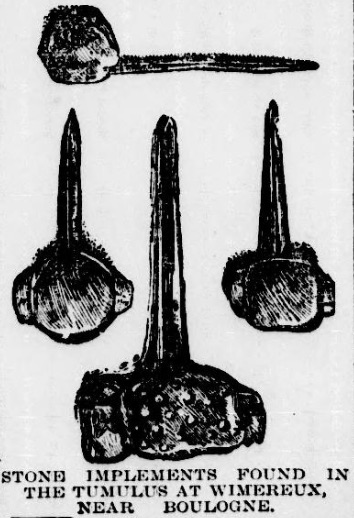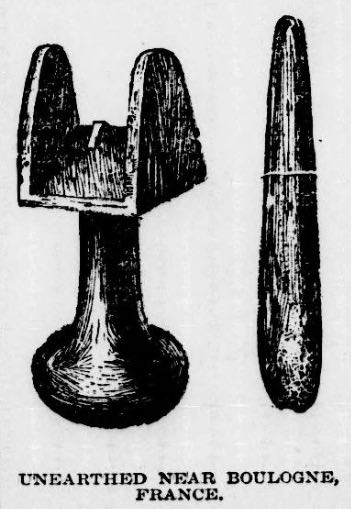
A landowner decided to have some mounds leveled on his property when the workmen discovered that the mounds were actually an ancient grave site.
Graveyard Under His Garden

One of the most interesting and important discoveries of the century has just been made at Wimereux, near Boulogne, where some of the most perfect relics of the stone age have been unearthed. Already 15 tomes have been opened and the skeletons and implements of household and agricultural utility that have been collected have delights the hearts of the scores of scientists who hurried to the spot as soon as the announcement of the find was made in the local and Paris journals.
Never in the history of the country have such perfect specimens been found and there is reason to believe that further explorations will unearth still greater wonders. Arrangements for such investigations are now being made as they are to be conducted under the direction of the greatest French scientists.
M. Sarce is one of the wealthiest of the land owners in the Wimereux district. Some time ago he decided to make some elaborate improvements in his property and gave orders that some mounds located on his estate should be leveled.

Although the soil all around the mounds was poor and sandy, the mounds themselves were found to be of excellent earth and the farm laborers were at once directed to place it on the vegetable garden. After the excavations had proceeded for some time the men came upon a number of tombs. Not realizing the importance of the discovery, the slabs of the tombs were thrown to one side and the skeletons they covered were carted away with the earth.
As soon as M. Sarce was informed of the discovery of the skeletons he stopped all work and had the bones that had been taken away replaced. He sent for Dr. Sauvage, the eminent archaeologist, and he notified other gentlemen who were interested in antiquities, all of whom went at once to Wimereux. Up to that time 11 tombs had been opened, but they soon discovered others, and before many hours had elapsed 15 tombs had been unearthed and examined.
The tumulus contained only these 15 stone coffins, which had been placed close together in a circle. They had been built up of large square slabs of Portland stone, which had evidently been obtained from the cliffs near Wimereux.
The coffins varied in length and ranged in depth from 12 to 18 inches. In most cases they consisted of stone on all sides, the slabs having been fitted together very neatly, but in two or three instances the skeleton lay directly upon the earth, showing that the body had been first placed in the grave, after which the coffin had been built up around it. The tops of the coffins were stone slabs of great size.
These tombs contained, in addition to the skeletons, several charred bones, some charred wood, and a reddish earth, that is supposed to be evidence of the practice of cremation that was followed in the Stone Age. In and around the tomb were unearthed many stone implements, such as flint axes and hammers, scrapers and knives of flint and other articles the use of which can scarcely be surmised. There were also many pebbles found in several of the larger coffins, and this was taken to be positive evidence that these had been the tombs of the warriors, as the pebble, in prehistoric times, was one of man’s chief weapons of attack, being thrown by means of slings.
The archaeologists who have examined the tombs express the belief that their presence in the coffins was due to a burial custom still common among primitive people, the idea being that the dead man would require in the future existence the same arms and implements as those to which he was accustomed when alive. Several scientists are also of the opinion that these articles were placed in the tumulus as an indication of mourning and respect for the deceased person.
As has been the case in other instances when tombs of the Stone age have been opened, many of the skeletons found at Wimereux were in such a poor state of preservation that some of them crumbled almost to powder on being touched. Fortunately, however, some of the bodies had been so well preserved that it has been possible to make a close examination of the skeletons and to obtain some measurements that have long been desired by students of archaeology.

One skeleton was found which was that of an adult man, who had suffered so severely from some form of rickets that he had been bandy-legged. His teeth, also, were well preserved, but one of the molars was decayed in such a manner as to show conclusively that toothache was one of the ills to which he had been subject during life.
Another peculiarity about the Wimereux tumulus is that all the bodies had been placed in a peculiar position at the time of burial. In each case the head had been placed upon a stone rest and always laid toward the north. The bodies rested on the right side, the arms being folded and the legs drawn up instead of being stretched out at full length.
In one case the body of the man buried had been covered by a thin slab of stone extending from the chin to the feet, and on this the mourners had placed the pebbles and the implements of warfare, after which the tomb had been closed in the usual manner with the heavy slab.
A close examination of the bones found in the coffins have led to the belief that they were those of a race of people who existed in one of the most remote of the prehistoric ages, probably in the early part of what is now known as the Stone Age, several of the implements of convenience used by men during the latter part of that period not having been found in the Wimereux tumulus.
There is every reason to believe that they represent a race of small men and judging from the shape of their skulls and jawbones they were people of extremely slight intelligence, who existed, not by slaying animals, but by eating shellfish or such fish as they could catch with their primitive appliances.
Since the news of the discovery was made public, several photographs of the tombs have been taken, while the relics themselves have been carefully collected by Dr. Sauvage, and they will be placed in the public museum at Boulogne. In the meantime arrangements are being made for a thorough exploration of the country around Wimereux in the hope that more tombs of this character may be discovered, in which case they will be closely examined by the scientists before they are wrecked by ignorant men.
Source: Daily inter mountain. (Butte, Mont.), 17 June 1899.

